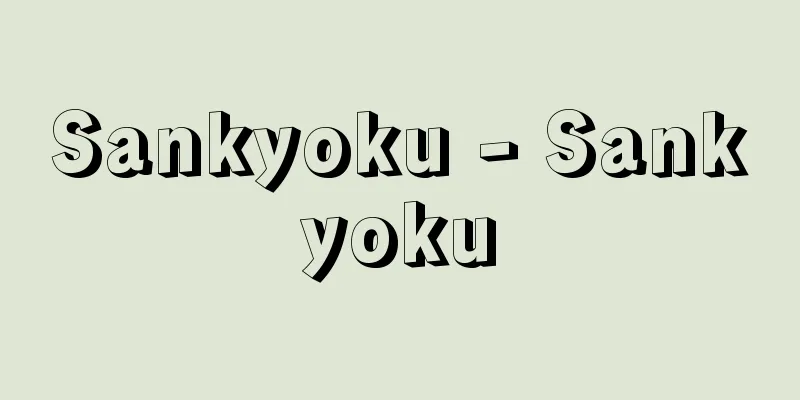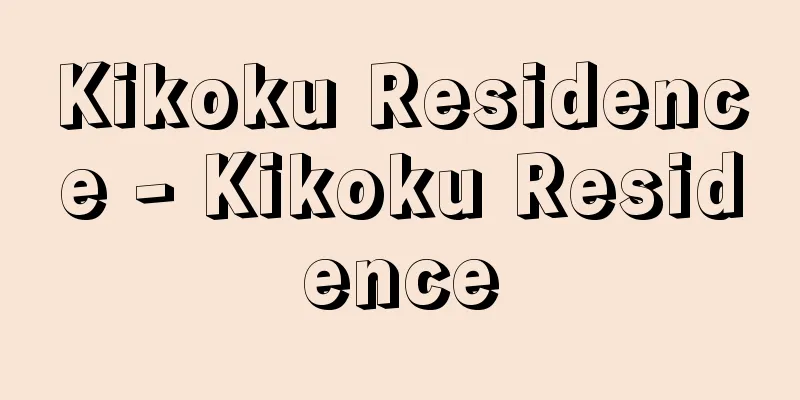Sankyoku - Sankyoku

|
A new type of song literature in the form of long and short phrases that emerged in China during the Yuan and Ming dynasties, inheriting the lyrics. The main reasons for its emergence seem to be a backlash against the monotony of lyrics that was popular mainly at banquets during the Tang and Song dynasties, and changes in musical compositions due to the influence of new Western music imported via the Mongols. There are two types of songs: Xiaoling, which sings a single theme by itself, and Taosu, which combines several songs belonging to the same palace (music) style and finishes with a converging song called Oisheng to sing a single theme. In the Yuan dynasty, it was made up of Northern songs using a seven-tone scale, and in the Ming dynasty, it was made up of Southern songs mainly based on a five-tone scale, but towards the end of the Yuan dynasty, the Northern and Southern Combinations, which combined Northern and Southern songs, also appeared. The differences between Northern Sanqu and Shi are that most of the Qupai (titles of musical styles) are short monotonous pieces, the disappearance of the Enter Tone (Nissho), the use of a common rhythm when rhyming, the more frequent use of slang, the emergence of more vulgar themes, and the use of words outside the verse structure called Xinzi (Xinzi), but in Southern Sanqu, there is a sense of returning to Shi. Many of the authors are also writers of plays, but there are also many who write only Sanqu. There are excellent works of folk songs in the Ming Dynasty, but there is no consensus on whether they should be called Sanqu or not. The number of Qupai exceeds 300 types in Northern Sanqu and reaches 800 types in Southern Sanqu. The basic books that explain the verse structure are the Taihe Zhengyin Pu in Northern Sanqu and the Revision of Nanjiugong Cipu in Southern Sanqu. However, as the Yuan dynasty sanqu was recently compiled into Quanyuan Sanqu by Sui Shusen, many people place more importance on Yuan sanqu. [Tamori Jo] "Chinese Classical Literature Series 20: Song Dynasty Poems" edited and translated by Takeshi Kuraishi (1970, Heibonsha) [Reference] | |Source: Shogakukan Encyclopedia Nipponica About Encyclopedia Nipponica Information | Legend |
|
中国、元(げん)・明(みん)両代に詞(し)を受け継いで現れた新しい長短句形の歌謡文学。唐~宋(そう)代に主として宴席で流行した詞のマンネリ化に対する反発と、モンゴル人経由で輸入された新しい西方音楽の影響による楽曲の変化とがその発生のおもな原因らしい。一曲だけで独立して一つの主題を詠む小令(しょうれい)と、同一宮(曲)調に属するいくつかの曲を組み合わせ、最後に尾声という収束の曲をつけて一つのテーマを詠む套数(とうすう)とがある。元代では7音階を用いる北曲に、明代では主として5音階を基調とする南曲によってつくられたが、元末には南北曲を組み合わせた南北合套も現れた。北散曲が詞と異なる点は、曲牌(はい)(楽曲の様式の題名)のほとんどが単調体の短章であること、入声(にっしょう)の消滅、押韻する場合の平仄(ひょうそく)通押、俗語のより頻繁な使用、より俚俗(りぞく)なテーマの出現、襯字(しんじ)とよばれる句格外の語の使用などがあげられるが、南散曲ではむしろ詞への回帰性が感じられる。作者の多くは戯曲の作者でもあるが、散曲のみの作者も多い。明代では民間の俗謡に優れた作があるが、それらを散曲と称するか否かの定説はない。曲牌の数は、北曲では300種を超え、南曲では800種に達する。句格の説明をした書は、北曲では『太和正音譜』、南曲では『重訂南九宮詞譜』が基礎的である。なお元代の散曲が近年隋(ずい)樹森(じゅしん)によって『全元散曲』にまとめられたように、元人散曲のほうを重視する人が多い。 [田森 襄] 『倉石武四郎編・訳『中国古典文学大系20 宋代詞集』(1970・平凡社)』 [参照項目] | |出典 小学館 日本大百科全書(ニッポニカ)日本大百科全書(ニッポニカ)について 情報 | 凡例 |
Recommend
Reichskanzler
…Prussia, which occupied almost two-thirds of the...
Complete Denture
...This is done to make the retainer function mor...
Ewald tube
…A thin tube inserted into the stomach through th...
Transcendental numbers
A number that is not a solution to an algebraic e...
Mission - Dendou (English spelling)
To spread religious teachings and "convey th...
Hot Spring Therapy - Onsenryoho
A type of hydrotherapy that uses water that conta...
zone index fossils
…Among the echinoderms, primitive stalked fossils...
flotas
… (1) Trade management All ships going to the New...
Tatsuo Takayama
Japanese painter. Born in Oita City. Studied unde...
madhyamā pratipad (English spelling) madhyamapratipad
...The fundamental position of Buddhist philosoph...
Blantyre (English spelling)
A commercial and industrial city in southern Malaw...
Kawasegaki - Kawasegaki
〘Noun〙① A segaki memorial service held in a river ...
Flathead flounder
A marine fish belonging to the order Pleuronectif...
Fundamental cycle
...Any periodic function of a real variable has a...
Okayama [city] - Okayama
Okayama City is located in the southern part of Ok...







![Saigawa [town] - Saigawa](/upload/images/67cba37eae10e.webp)

